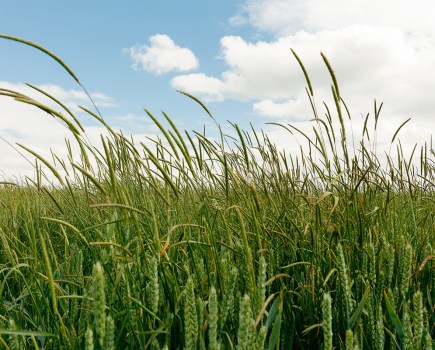By Andrew Wilson
Somewhat predictably, given the rain, it’s a light land year. Our winter barley is all cut and varied in yield from not quite 6t/ha to a reasonable 7.9t/ha, with the average tantalisingly close to 7t/ha. In old money, it’s not quite done three ton! There’s a decent amount of straw though, and we haven’t yet had to start the dryer up, which is pleasing.
The wheat will be next, which is variable – the yield difference between area sown and area harvested will be a little depressing, but what is there looks decent quality at least. The early sown spring barley will follow on, with a mishmash of oats and barley as they get fit and beans sometime in September.
Prices are a bit rubbish, but root crop driven cashflow dictates that we’ve sold some of our crop. The markets take some following these days, so I pretty much do the same as dad did – sell about a third of expected harvest forward, a third at harvest, and sell whatever is left when the price looks like it’s a good idea to shift it. Being the cynic that I am, low wheat price equals cheaper fertiliser, so I’ve bought a load of urea!
Root crops look half decent at the moment. We’ve managed to avoid cercospora and virus in the beet so far and have fed it some trace elements and salt in the recent sunshine. Will it stack up next year? I have to say I’m not exactly hanging the bunting out over next year’s contract proposal so our area will see a trim.
As seems to be the case too frequently, we’re required to provide ever more data for free just for the privilege of selling our crops. This is becoming tiresome, not least because of the absolute disregard for the effort required to provide this information for no extra income. The whole process of growing the crop has become higher risk and more time demanding – essentially far more of a ‘chew on’ than ever it used to be, for a smaller reward.
One can no longer fix the price of 100% of contract, which raises the risk immediately. The market has to lift significantly for there to be extra meaningful reward to offset that risk. Futures in the last twelve months have moved by more than 100%. I guess when the market is at its current low, surely things will improve – I’m ever the optimist.
The potatoes always look good in full flower – it covers up any puny plants and feels good driving through them with the sprayer. Speed of growth has been significant as it always is in a late season, and in some fields, we’ve had to be keen with trace elements to maintain momentum.
Maleic hydrazide (MH) timing is upon us, but at this point in time (early August) just coming out of a hot spell, I’d prefer cooler days rather than just cool nights. MH is the absolute cornerstone of sprout control for us and it always pays to be fussy over its application which can be frustrating sometimes, not least because it’s not a fast job at 500 l/ha!
The rots in seed that I spoke of last month have produced some puny blackleg infected plants, which will hopefully dissolve sufficiently to not be a problem at harvest or in store. We’ve also managed so far to keep blight out of our crops, but I’m not looking forward to working out what it’s cost to do so.
Rainfall in reasonable amounts has kept the irrigators parked up for most of the season, and with August often the wettest month of the year and more bodied land than normal, will it stay that way? Hopefully – I’d rather dry a bit of corn than lay more pipes this late.
Cover crop drilling here will be a spread-out affair, with a couple of fields now cleared but most still occupied by wheat or late sown spring cereals. I’ve had a review of how we go about this mission, and for various reasons, have simplified our seed mixes from the six we had last year to three this time.
Principally, one for high nematode pressure, one for low nematode pressure and one for pre-spring cereals. This is inevitably partly driven by seed cost, but also efficiencies in getting them sown with a smaller team than normal. I drilled my first cover crop back in 2011 and every year since has seen some learning both from our own activities and that of others, be that other farmers, trials, research bodies or seed suppliers.
My philosophy is simple – fundamentally I believe that there’s always a better way of doing everything and if it works, keep doing it, if it doesn’t, work out why and change it. What’s often overlooked with cover crops is the side effects – some components can have a negative effect on things like free living nematodes which can affect future cropping.
Diversity is key, but not at any price. What I’ve found is that a four-way mix works very well. Two isn’t sufficient and anything over six is unnecessary. Our pre-root crop mix this year includes a multi-resistant radish, vetch, buckwheat and oats. High nematode pressure essentially dictates two varieties of radish and black oats as opposed to normal tame oats, which is obviously a more expensive mix.
Taty lifting (as we call potato harvesting in these parts) and cereal drilling will soon be upon us, so may I wish everyone a fruitful and safe back end.
This article was taken from the latest issue of CPM. For more articles like this, subscribe here.
Sign up for Crop Production Magazine’s FREE e-newsletter here.




